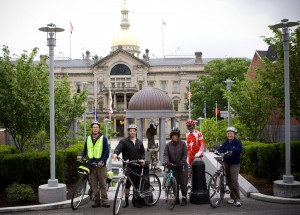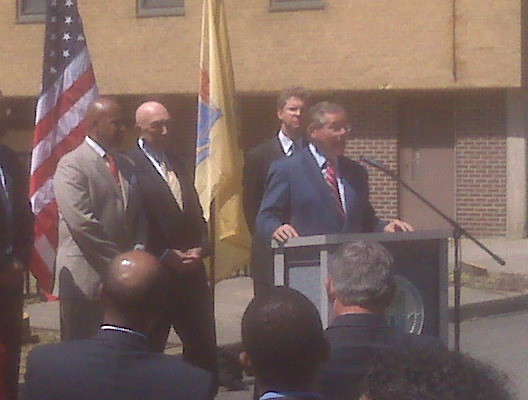New Jersey Future Blog
So you passed a Complete Streets policy. NOW what?
February 21st, 2013 by New Jersey Future staff
 What are Complete Streets? The National Complete Streets Coalition describes them as streets “designed and operated to enable safe access for all users. Pedestrians, bicyclists, motorists, and public transportation users of all ages and abilities are able to safely move along and across a complete street.” Over the past 30 years, many streets and roads have been designed exclusively for cars, and have little accommodation for pedestrians or cyclists. However, with increasing demand for more walkable communities with public transit options, many towns in New Jersey are either adopting or considering adopting a policy that requires consideration of all users, not just drivers, in any future street construction or repair. Support for such a policy usually comes in the form of a Complete Streets resolution, passed by the local governing body. (A list of what an ideal Complete Streets resolution should include is available here.)
What are Complete Streets? The National Complete Streets Coalition describes them as streets “designed and operated to enable safe access for all users. Pedestrians, bicyclists, motorists, and public transportation users of all ages and abilities are able to safely move along and across a complete street.” Over the past 30 years, many streets and roads have been designed exclusively for cars, and have little accommodation for pedestrians or cyclists. However, with increasing demand for more walkable communities with public transit options, many towns in New Jersey are either adopting or considering adopting a policy that requires consideration of all users, not just drivers, in any future street construction or repair. Support for such a policy usually comes in the form of a Complete Streets resolution, passed by the local governing body. (A list of what an ideal Complete Streets resolution should include is available here.)
Once the resolution is passed, what are the best ways to make sure it’s implemented well?
The New Jersey Department of Transportation’s recently released Guide to Creating a Complete Streets Implementation Plan offers some guidance for implementation of local Complete Streets policies:
“There are five main elements to implementing a Complete Streets policy:
- Updating plans, policies, and procedures to incorporate Complete Streets principles;
- Incorporating Complete Streets into the development process;
- Building institutional capacity through training, communication, and monitoring;
- Creating partnerships; and
- Initiating pilot projects to build support and demonstrate the value of Complete Streets.”
The first, and most important step, is to pass a good Complete Streets resolution that includes specific steps that can be followed and that allows progress to be tracked. The City of Trenton’s 2012 Complete Streets resolution offers a practical example of a good policy. Among its three specific action steps, Trenton’s policy directed that “the Trenton Station Linkage Plan, prepared for the city by Nelson/Nygaard in 2006, shall be revisited, with a specific focus on designating appropriate routes for pedestrians, dedicated bike lanes and preferred bicycle routes (shoulders or shared travel lanes with appropriate signage and/or pavement markings). The City Engineer shall coordinate this effort in collaboration with the Traffic Analyst and update City Council within 180 days of this resolution.” This type of concrete directive, with a clearly designated responsible party and a deadline, provides the basis for benchmarking progress.
But what if your community already passed a Complete Streets policy and it didn’t include action steps that you can monitor? Implementation in these cases typically relies on education, engagement and partnerships.
First, make sure city staff and other stakeholders know about the policy. Before other plans, policies and procedures can incorporate Complete Streets principles, relevant staff and board members need to know the new policy exists. Making sure the concept is explained to relevant parties can start an important conversation about the policy and its implications. Be sure to include volunteer members of your planning and zoning board as well as paid staff and consultants.
In Trenton, an explanatory memo was used to invite staff and stakeholders to a workshop. By partnering with the Partnership for Healthy Kids-Trenton, an umbrella organization of community representatives, the city was able to bring in certified Complete Streets trainers to lead staff and other stakeholders in a half-day training workshop. This training helped solidify the meaning of the policy and flesh out what steps various parties would take to ensure successful implementation moving forward.
Shortly after the training sessions took place the Partnership for Healthy Kids forged another partnership, this time with the Trenton Downtown Association. Stakeholders who had attended the training were invited to participate in a walk audit of the downtown business district. Walk audits engage the community in identifying needs and can inform city planners about potential improvements that can be made to the streetscape. (For more information on walk audits, consider attending a walk audit of a section of New Brunswick as part of New Jersey Future’s 2013 Redevelopment Forum.) Ideally, the efforts to identify needs will initiate pilot projects to support and demonstrate the value of Complete Streets, and address the concerns of participating community members.
Other valuable implementation steps worth considering include:
- Adopting a checklist. A checklist can help staff consider the needs of all users at every opportunity. NJDOT has an example checklist that can be customized (pages 16-22)
- Revisiting the local master plan in order to incorporate Complete Streets principles. Does the existing plan have a mobility element?
- Mapping bicycle and pedestrian connections. Identifying existing bike/ped facilities may illuminate areas in need of improvement.
The two guides from NJDOT, posted on the Complete Streets section of its website, and their appendices, offer even more resources.
The recent 2012 planning conference of the American Planning Association New Jersey Chapter included a presentation on the process of getting a Complete Streets policy adopted and implemented in the City of Trenton.
















